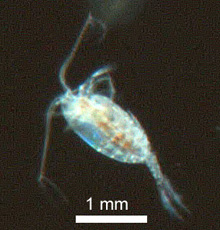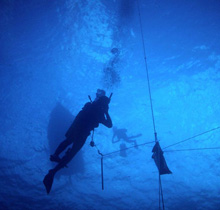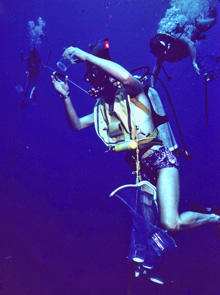Bluewater divers silhouetted against the ocean surface. The safety diver (in the foreground) carries a short stick hanging down from his clip to push away curious sharks. The other diver swims with a collecting bag filled with jars to hold small animals. Another bag is clipped to the down-line below the trapeze. The lines on the right side of the photo are clipped to two other divers (not shown). Click image for larger view and image credit.
Bluewater Diving
Peggy Hamner
Staff Research Associate and Co-director, COSEE-West
University of California, Los Angeles
William Hamner
Professor Emeritus
University of California, Los Angeles
Why Do Researchers Go Bluewater Diving?
Marine biologists dive with scuba in the open ocean to observe and collect undisturbed and undamaged organisms — usually animals called zooplankton — that live in the water column from the surface down to about 100 feet. The ocean away from land is clear and blue, so the technique is called "bluewater" diving. It is a particularly important way to study soft-bodied gelatinous animals, such as jellyfish, because these animals are terribly damaged or destroyed when they are caught in nets.
Bluewater diving is also the best way to learn how any undisturbed pelagic (open sea) animal behaves in its natural environment. Animals that live in the water column away from the sea floor never run into floors or ceilings or walls, so they have not adapted to encountering surfaces. There's simply no need for them to do so. When these animals are put into an aquarium, it is difficult to know how much their physical confinement within the container’s walls alters the way they behave. Entering their natural underwater environment allows the scientist to learn about their normal behaviors.
Diving Procedure
Diving in the open ocean is much like walking in space. There are no landmarks to keep divers oriented, and usually the sea floor is far below and out of sight. So, although the technique of bluewater diving is simple, the safety procedures that keep scuba divers from getting lost are extremely important. Bluewater divers usually work from a small boat launched from a mother ship. Once the boat is a safe distance from the ship, the divers tie a surface float to the boat with a floating rope about 20 feet (ft) long. A “down-line,” 100 to 120 ft long, hangs down from the float, and a small trapeze is clipped onto the down-line. After getting into the water, each diver is tethered by a separate line to the trapeze. This tether system prevents the divers from drifting away, and the boat driver can communicate with the divers by tugging on the down-line.
A group of up to four scuba divers works together. One of them is the "safety" diver, who stays close to the down-line and acts as buddy for the other divers. The safety diver watches for hazards such as curious sharks, handles the lines running through the trapeze, and relays signals between divers. The safety diver slides the trapeze up and down along the down-line so that the tethered divers can search for animals at different depths. Each diver, whose task is to observe and collect animals, is clipped onto one end of a 30-ft line that runs through a clip on the down-line trapeze. A small weight tied to the other end pulls the line taut so that it is easier for the working diver to avoid getting tangled in it. With these lines, the divers can search for animals out to 30 ft away from the down-line in all directions.
Chief Scientist Larry Madin (center) collects transparent zooplankton. Peggy Hamner (upper left) acts as safety diver and William Hamner swims down (from the right). This photo, used with permission from the National Geographic Society, first appeared in the article “Blue-Water Plankton,” written by William Hamner for the October 1974 issue of National Geographic Magazine. That article described the first use of scientific bluewater diving, conducted in a research project in the Gulf Stream off Bimini, Bahamas, directed by Dr. Hamner. At that time he was teaching at the University of California, Davis, and Peggy and Larry were his graduate students. Click image for larger view and image credit.
Bluewater dives typically last for 30 to 60 minutes. The time depends on water temperature, the depth at which the divers work, and how hard they swim. Only no-decompression diving is practiced, with mandatory safety stops as the divers ascend, to be sure that no nitrogen bubbles remain in the blood stream. Dive computers that continuously record depth and time let the divers know how long they can safely stay underwater. The no-decompression tables that scuba divers use for bottom dives are not as accurate for bluewater diving because the divers continuously move up and down through the water column as they search for animals.
The one weather factor that can cancel a bluewater dive is the wind. The boat driver has to keep the engine running and keep strain off the rope tied to the float so that the divers underwater don’t get dragged through the water by currents or wind pushing the boat across the surface. When the wind blows harder than 20 knots (nautical miles per hour), it is difficult to handle the small boat and to keep the rope between the boat and the surface float slack. Bigger waves generated by the wind also make launch and recovery of the boat by the ship’s crew difficult.
Celebes Sea Bluewater Dives
One exciting aspect of this cruise is the possibility of so many new discoveries! Many organisms that hide in deep water during daylight hours swim up toward the surface at night to feed. That's one reason why it is important to learn about the assemblages of animals in the top 100 ft of the open ocean, both in the day and at night. On all of our bluewater dives in the Celebes Sea, we will collect zooplankton (such as jellyfish and ctenophores) in wide-mouth jars that we carry in mesh bags; and on night dives we will add underwater flashlights or headlamps to our gear. We will photograph undisturbed animals with underwater still and video cameras and bring back undamaged live individuals to study in aquariums aboard ship.
In the surface waters that can be reached by scuba divers we might collect live individuals of species never before recorded for the Celebes Sea. Certainly, we can realistically expect to bring back images of animals that have never before been seen alive.





























